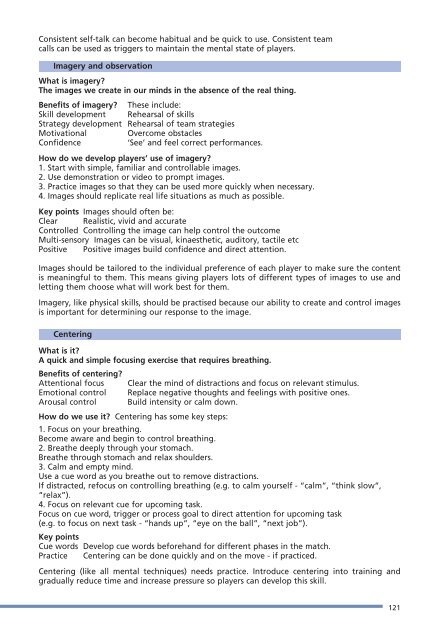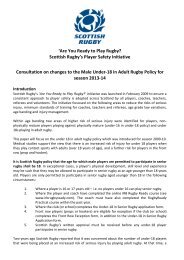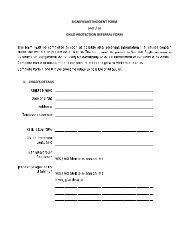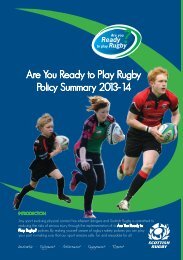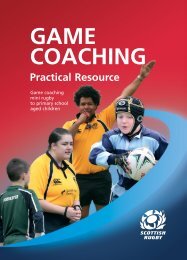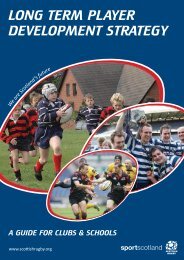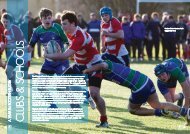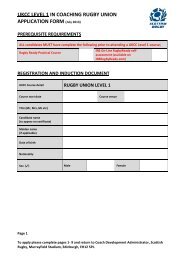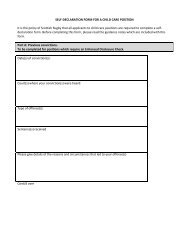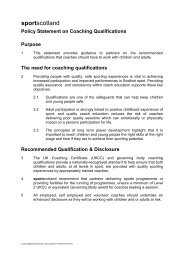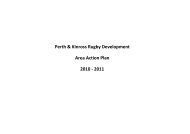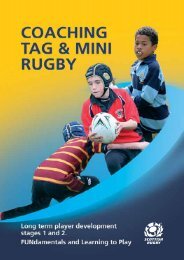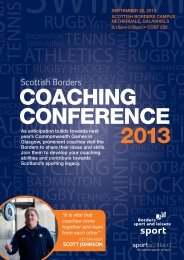LTPDst3cover.qxd (Page 1) - Scottish Rugby Union
LTPDst3cover.qxd (Page 1) - Scottish Rugby Union
LTPDst3cover.qxd (Page 1) - Scottish Rugby Union
- No tags were found...
Create successful ePaper yourself
Turn your PDF publications into a flip-book with our unique Google optimized e-Paper software.
Consistent self-talk can become habitual and be quick to use. Consistent teamcalls can be used as triggers to maintain the mental state of players.Imagery and observationWhat is imagery?The images we create in our minds in the absence of the real thing.Benefits of imagery? These include:Skill development Rehearsal of skillsStrategy development Rehearsal of team strategiesMotivationalOvercome obstaclesConfidence‘See’ and feel correct performances.How do we develop players’ use of imagery?1. Start with simple, familiar and controllable images.2. Use demonstration or video to prompt images.3. Practice images so that they can be used more quickly when necessary.4. Images should replicate real life situations as much as possible.Key points Images should often be:Clear Realistic, vivid and accurateControlled Controlling the image can help control the outcomeMulti-sensory Images can be visual, kinaesthetic, auditory, tactile etcPositive Positive images build confidence and direct attention.Images should be tailored to the individual preference of each player to make sure the contentis meaningful to them. This means giving players lots of different types of images to use andletting them choose what will work best for them.Imagery, like physical skills, should be practised because our ability to create and control imagesis important for determining our response to the image.CenteringWhat is it?A quick and simple focusing exercise that requires breathing.Benefits of centering?Attentional focus Clear the mind of distractions and focus on relevant stimulus.Emotional control Replace negative thoughts and feelings with positive ones.Arousal control Build intensity or calm down.How do we use it? Centering has some key steps:1. Focus on your breathing.Become aware and begin to control breathing.2. Breathe deeply through your stomach.Breathe through stomach and relax shoulders.3. Calm and empty mind.Use a cue word as you breathe out to remove distractions.If distracted, refocus on controlling breathing (e.g. to calm yourself - “calm”, “think slow”,“relax”).4. Focus on relevant cue for upcoming task.Focus on cue word, trigger or process goal to direct attention for upcoming task(e.g. to focus on next task - “hands up”, “eye on the ball”, “next job”).Key pointsCue words Develop cue words beforehand for different phases in the match.Practice Centering can be done quickly and on the move - if practiced.Centering (like all mental techniques) needs practice. Introduce centering into training andgradually reduce time and increase pressure so players can develop this skill.121


